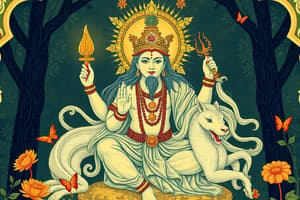Podcast
Questions and Answers
Who are some notable authors of Classical Hindi Literature mentioned in the text?
Who are some notable authors of Classical Hindi Literature mentioned in the text?
- Amir Khusrau, Kabir, Tulsidas (correct)
- Premchand, Rajendra Kishore, Krishna Sobti
- Mahadevi Verma, Sahir Ludhianvi, Shamshad Begum
- Munshi Premchand, Rabindranath Tagore, Bankim Chandra Chattopadhyay
Which period gave rise to Modern Hindi Literature that focused on social and political issues?
Which period gave rise to Modern Hindi Literature that focused on social and political issues?
- Late 19th and early 20th centuries (correct)
- 18th century
- 10th century
- Early 20th century
Who are some renowned Hindi poets mentioned in the text?
Who are some renowned Hindi poets mentioned in the text?
- Sahir Ludhianvi, Shamshad Begum, Munshi Premchand
- Mahadevi Verma, Sahir Ludhianvi, Shamshad Begum (correct)
- Amir Khusrau, Kabir, Tulsidas
- Premchand, Rajendra Kishore, Krishna Sobti
What forms of literary works are present in Classical Hindi Literature?
What forms of literary works are present in Classical Hindi Literature?
Who are some notable writers who have contributed significantly to Hindi literature?
Who are some notable writers who have contributed significantly to Hindi literature?
Which authors have contributed to the development of modern Hindi drama?
Which authors have contributed to the development of modern Hindi drama?
Which genre has seamlessly intertwined with Hindi literature according to the text?
Which genre has seamlessly intertwined with Hindi literature according to the text?
How has Hindi literature been enriched according to the text?
How has Hindi literature been enriched according to the text?
What aspect of Hindi literature continues to evolve in the digital age?
What aspect of Hindi literature continues to evolve in the digital age?
What is a characteristic of Hindi Sahitya as highlighted in the text?
What is a characteristic of Hindi Sahitya as highlighted in the text?
Flashcards are hidden until you start studying
Study Notes
Exploring Hindi Sahitya: The Rich World of Hindi Literature
Hindi Sahitya, or Hindi literature, encompasses an expansive and diverse array of literary works that span multiple centuries, reflecting the cultural, social, and historical aspects of the Hindi-speaking world. As the most widely spoken language in India, Hindi has seen an immense growth in literature, with various subtopics captivating the readers' imagination.
1. Classical Hindi Literature
Classical Hindi literature traces its roots back to the 10th century, featuring poetry, prose, essays, and drama. Notable authors from this era include Amir Khusrau, Kabir, and Tulsidas. Their works laid the foundation for Hindi's journey into modern times, merging classical storytelling techniques with contemporary themes.
2. Modern Hindi Literature
Modern Hindi literature emerged in the late 19th and early 20th centuries with a focus on social and political issues. Prominent writers like Premchand, Rajendra Kishore, and Krishna Sobti brought forth new ideas and perspectives, addressing societal problems and challenging traditional norms.
3. Hindi Poetry
Hindi poetry has flourished over time, with poets like Mahadevi Verma, Sahir Ludhianvi, and Shamshad Begum leaving an indelible mark. Poetry in Hindi varies in style and theme, allowing for the expression of myriad emotions.
4. Hindi Novels and Short Stories
The Hindi novel and short story have evolved to include a broad range of subjects and perspectives. Notable writers like Mulk Raj Anand, Ramesh Chandra Shah, and Nirmal Verma have contributed invaluably to Hindi literature through their compelling narratives.
5. Hindi Drama and Theater
Hindi drama and theater have significantly impacted the growth of Hindi literature. Notable authors like Vijay Tendulkar and Girish Karnad have contributed to the development of modern Hindi drama, engaging audiences with their thought-provoking performances.
6. Hindi Cinema and Literature
Hindi cinema, or Bollywood, has seamlessly intertwined with Hindi literature, with many films based on literary works. Notable examples include the adaptations of Premchand's novels, like "Sarfarosh" and "Shool." Hindi cinema has also inspired literary works, with authors like Shamim Hanafi exploring the world of Bollywood in his book "Umrao Jaan Ada."
7. Translation and Regional Influences
Hindi literature is influenced by regional languages and translated works, as evident in the works of writers like Maithili Sharan Gupt, who translated the epic poem "Mahabharata" into Hindi. Hindi literature has also been enriched by regional literary works like the Gujarati novel "Kai Po Che," which was adapted into Hindi as "The Hundred-Foot Journey."
8. Hindi Literature in the Digital Age
Hindi literature continues to evolve in the digital age, with the rise of e-books, audiobooks, and digital publishing. Platforms like Kindle and Audible have made Hindi literature accessible to a global audience, allowing readers worldwide to experience the richness and depth of Hindi Sahitya.
Hindi Sahitya is a treasure trove of enthralling narratives, captivating poetry, and thought-provoking drama. With its emphasis on human emotions and societal issues, Hindi literature continues to flourish as an integral facet of Indian culture.
Studying That Suits You
Use AI to generate personalized quizzes and flashcards to suit your learning preferences.




